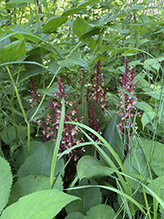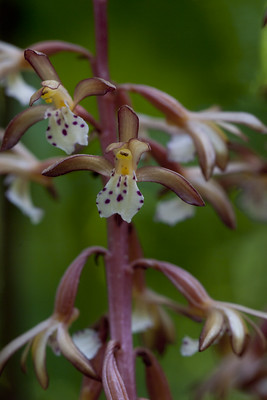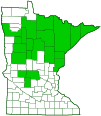western spotted coralroot
(Corallorhiza maculata var. occidentalis)
Conservation • Wetland • Description • Habitat • Ecology • Use • Distribution • Taxonomy
Description |
||
Western spotted coralroot, also called summer coralroot, is a common, perennial, leafless, rootless, parasitic orchid. It occurs in the United States in the east from Maine to New York, west to northern Minnesota, and in the west from northern Washington and southern California, east to Montana and New Mexico. It also occurs in southern Canada from Nova Scotia to British Columbia, and in Mexico. It is fairly common in northeastern and north-central Minnesota. It is found in moderately moist, upland, mixed and coniferous forests and in conifer plantations. It grows on the ground under mature deciduous trees and sometimes under mature coniferous trees. Western spotted coralroot is not photosynthetic and does not produce chlorophyll. It obtains all of its nutrients from fungi in the soil (mycotrophic). Instead of roots it has a large, intricately branched, coral-like, underground stem (rhizome). This is the feature that gives the genus its common name. The rhizome is white, deeply buried, and up to 4″ (10 cm) long. The branches are short and stiff, and they have rounded tips. Each branch is capable of giving rise to a flowering stem, but not all of them do. The flowering stem (scape) is erect, unbranched, hairless, and 6″ to 21⅝″ (15 to 55 cm) in height. It is not bulbous at the base. The color is variable, usually dark and reddish or purplish, sometimes light and brownish-yellow. There are no true leaves. On the lower part of the scape there are 2 or 3 modified leaves (bracts) that surround (sheath) the stem but have no blades. The sheaths are hairless and the same color as the scape. At the top of the stem there is an unbranched, 1¼″ to 6″ (3 to 15 cm) long cluster (raceme) of 6 to 50 conspicuous flowers. Each flower is subtended by a tiny, lance-shaped, 1⁄32″to ⅛″ (1 to 2.8 mm) long bract. These floral bracts are often forked. The flowers bloom from June 10 to July 18, peaking in the last two weeks of June. Each flower has 3 outer floral leaves (sepals), 3 petals, 1 stamen, and 1 style. The sepals are lance-shaped, directed forward, and 3⁄16″ to ⅝″ (4.7 to 15 mm) long. They have 3 veins and are brown, tan, red, or yellow, often reddish-purple at the tip becoming yellowish at the base. The lateral petals are similar to the sepals but shorter, lighter, usually spotted with purple, and frequently curved inward. The sepals and the lateral petals together form a protective hood over the reproductive column. The lower petal (lip) is white and is usually spotted with purple. There are two small, rounded, lateral lobes near the base. The middle lobe is much larger, 3⁄16″ to 5⁄16″ (4.5 to 8.0 mm) long, ⅛″ to ¼″ (3 to 6 mm) wide. It is egg-shaped, slightly curved downward, and distinctly expanded toward the end. The expanded part of the lobe is more than 1.5 times wider than the base of the lobe. The margin is wavy. The column consists of the style fused to the stalk (filament) of the stamen. It is curved and ⅛″ to 5⁄16″ (3.5 to 7.8 mm) long. The fruit is an oblong ellipse shaped, ⅜″ to 15⁄16″ (9 to 24 mm) long, 3⁄16″ to ⅜″ (5 to 9 mm) wide seed capsule that hangs loosely downward. |
||
Height |
||
6″ to 21⅝″ (15 to 55 cm) |
||
Flower Color |
||
White spotted with purple |
||
Similar Species |
||
Eastern spotted coralroot (Corallorhiza maculata var. maculata) floral bracts are much smaller, 1⁄64″ to 1⁄32″ (0.5 to 1.0 mm) long. The middle lobe of the lip is 1⁄16″to ⅛″ (1.5 to 4.5 mm) wide and straight sided, more or less uniform in width from the base to the tip. It blooms later, July 1 to August 10, peaking around the middle of July. |
||
Habitat |
||
Moderately moist, upland, mixed and coniferous forests |
||
Ecology |
||
Flowering |
||
June 10 to July 18 |
||
Pests and Diseases |
||
|
||
Use |
||
|
||
Distribution |
||||
|
Sources |
|||
| 6/22/2023 | ||||
Nativity |
||||
Native |
||||
Occurrence |
||||
|
||||
Taxonomy |
|||
| Kingdom | Plantae (Plants) | ||
| Subkingdom | Pteridobiotina | ||
| Phylum | Tracheophyta (Vascular Plants) | ||
| Class | Liliopsida (Monocots) | ||
Order |
Asparagales (Agaves, Orchids, Irises, and Allies) | ||
Family |
Orchidaceae (orchids) | ||
| Subfamily | Epidendroideae (lower Epidendroideae) | ||
| Tribe | Epidendreae | ||
| Subtribe | Calypsoinae | ||
Genus |
Corallorhiza (coralroots) | ||
| Species | Corallorhiza maculata (spotted coralroot) | ||
The original spelling of this genus in 1755 was Corallorrhiza, with two “r”s. It was later changed to Corallorhiza with one “r”, a “conserved” name. |
|||
Subordinate Taxa |
|||
|
|||
Synonyms |
|||
Corallorhiza maculata ssp. occidentalis Corallorhiza maculata var. flavida Corallorhiza maculata var. immaculata Corallorhiza maculata var. intermedia Corallorhiza maculata var. punicea Corallorrhiza maculata ssp. occidentalis Corallorrhiza maculata var. flavida Corallorrhiza maculata var. immaculata Corallorrhiza maculata var. intermedia Corallorrhiza maculata var. punicea |
|||
Common Names |
|||
summer coralroot spotted coralroot western spotted coralroot |
|||
Glossary
Bract
Modified leaf at the base of a flower stalk, flower cluster, or inflorescence.
Column
The united filaments and style of an orchid. The structure formed by the united filaments of plants in the Mallow family.
Filament
On plants: The thread-like stalk of a stamen which supports the anther. On Lepidoptera: One of a pair of long, thin, fleshy extensions extending from the thorax, and sometimes also from the abdomen, of a caterpillar.
Mycotrophic
Receiving nutrients from the mycorrhizal fungus on the roots of a host plant.
Raceme
An unbranched, elongated inflorescence with stalked flowers. The flowers mature from the bottom up.
Rhizome
A horizontal, usually underground stem. It serves as a reproductive structure, producing roots below and shoots above at the nodes.
Scape
In plants: An erect, leafless stalk growing from the rootstock and supporting a flower or a flower cluster. In insects: The basal segment of the antenna.
Sepal
An outer floral leaf, usually green but sometimes colored, at the base of a flower.
Visitor Photos |
|||||
Share your photo of this plant. |
|||||
| This button not working for you? Simply email us at info@MinnesotaSeasons.com. Attach one or more photos and, if you like, a caption. |
|||||
Kathy Ross |
|||||
 |
|||||
MinnesotaSeasons.com Photos |
|||||
|
|||||

Slideshows |
||
| Corallorhiza maculata Ben Rostron |
||
 |
||
About
Spotted Coral Root orchid |
||
| Corallorhiza maculata var. occidentalis forma punicea Mark Fleming |
||
 |
||
About
Spotted coralroot |
||

Visitor Videos |
|||
Share your video of this plant. |
|||
| This button not working for you? Simply email us at info@MinnesotaSeasons.com. Attach a video, a YouTube link, or a cloud storage link. |
|||
Other Videos |
|||
| Spotted A Spotted Coralroot! Mountain Misery |
|||
About
May 15, 2019 90 seconds with Corallorhiza maculata |
|||
| Spotted Coralroot, Corallorhiza maculata Spotted Coralroot, Corallorhiza maculata |
|||
About
Jul 30, 2016 One of the least observed orchids in the Oak Openings, the Spotted Coralroots thrusts its flower stalk, naked but for a leaf sheath clasping its stem, from the dark forest floor in mid-summer |
|||
| The spotted coral root, Corallorhiza maculata, on the perimeter trail, Ouray, Colorado. Mike's thoughts on plants. |
|||
About
Jul 4, 2021 This is one of two species I have found of the coral root orchid, this is the more common generally in the west, but C. stricta is more common locally. |
|||
| Native Spotted Coralroot Orchids in the forest BananaJSSI |
|||
About
May 10, 2020 Corallorhiza maculata, or spotted coralroot, is a North American coralroot orchid. Varieties are also known as western coralroot and summer coralroot. It is widespread through Mexico, Guatemala, Canada, St. Pierre & Miquelon, and much of the Western and northern United States. It grows mostly in montane woodlands. |
|||

Created: 6/22/2023
Last Updated:


